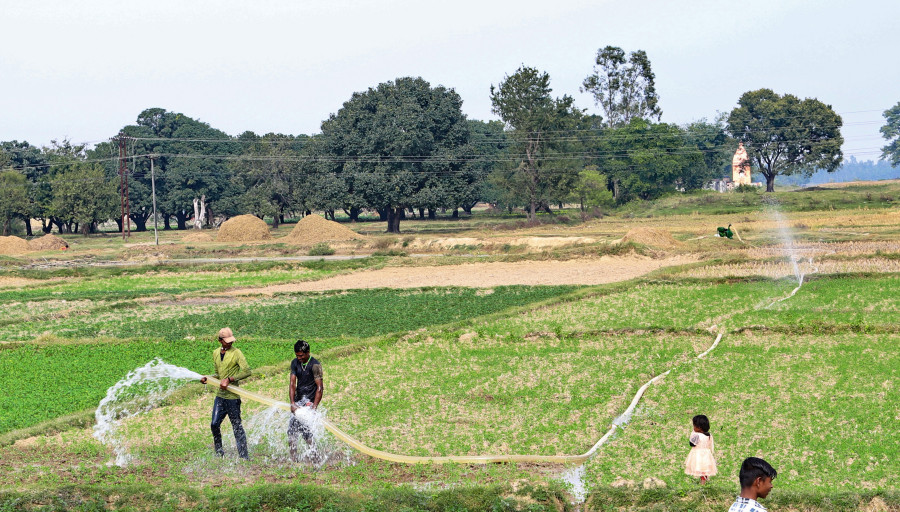Columns
The water and food nexus
Despite Nepal's vaunted water resources, there isn't enough for growing more food.
Khem Raj Sharma
Nepal's location squeezed between China and India has created a high degree of economic dependency, particularly on the southern neighbour, as it controls access to the sea and, through trade and transit agreements, can set conditions for the exchange of goods and services. These attributes have played a part in shaping the predominantly agrarian-based economic status of the country. But for over the last two decades, the agriculture sector in Nepal has not been able to maintain pace with the ever-growing food demand. From its food exporting position, the country has turned into a food deficit country. And food imports, mainly from India, have been skyrocketing, increasing the trade deficit with that country. Growing more food and returning the country to its original food exporting status remains a significant challenge.
Even though Nepal is tagged as a water resource-rich country and much focus in the country’s periodic plans has been put on developing the irrigation systems, there is not enough water resources as desired for growing more food. Though food production is the outcome of interactions between many crop inputs, water is the key ingredient. Management and access to irrigation is essential in the farmers’ livelihood and poverty context. Numerous studies have pointed out that the performance of irrigation systems is far lower than initially planned as the water supply is not adequate, efficient, reliable, flexible and equitable. The irrigation systems in Nepal are mainly run-of-the-river types which provide little leverage to control water flow in the canals. In the dry season, water flows in almost all rivers drop. This does not support intensive irrigated cropping, and only one crop in the monsoon season is cultivated in general.
Rural poverty
Unless the irrigation systems can promote intensive cropping, engaging the farmers actively for at least eight months in a year, the envisaged benefits in agriculture cannot be realised. Seasonal employment in farming is a cause of rural poverty, and the people continue looking for better employment opportunities. This is why most of the working-age personnel (15-65 years), which is projected to be around 67 percent of the total population, are migrating to urban centres in the country or going abroad for employment. Consequently, there is a labour shortage during the peak farming seasons, and large swathes of farm lands are reported uncultivated in many districts of the country.
Evidence shows that crop yields from irrigated areas that receive water as per demand are far higher than from those served by seasonal canal systems. When there is an assured irrigation water supply, farmers are willing to invest in productive inputs and harvest the maximum yields. Besides that, the provision of adequate and timely irrigation helps extend water supplies to new command areas and increases cropping intensities. For example, the ongoing programmes of interbasin water diversion like Bheri-Babai and Sunkoshi-Marin-Bagmati are expected to provide year-round irrigation to thousands of hectares of agricultural lands in Banke and Bardia as well as in Sarlahi and Rautahat districts. These irrigation-led multipurpose projects, along with many other benefits, will generate hydroelectricity and increase environmental flows for maintaining the river's biodiversity. These multipurpose programmes will be more cost-effective as the two major components, irrigation and hydropower, share the total cost. This way, the water-food-energy-environment nexus will be maintained, which eventually will be instrumental in creating system sustainability.
Ways forward
Nepal's agricultural imports went up to Rs325 billion in 2020-21, which is 30 percent higher than in the previous year. Rice is the most significant food import. This demands changing our food habit from rice to non-rice foods like maize, wheat, finger millet, barley and others which are locally produced and are rich in nutrients.
The country has no option other than boosting agricultural production and becoming self-sufficient. This implies that the importance of irrigation is ever increasing as sustaining agricultural production relies not only on water productivity but also on increasing the contribution of other growth factors like improved seeds and chemical fertiliser. The degree of control that an irrigation system allows is of utmost significance. This suggests that focus should be put on having reliable irrigation, which is possible also by creating water storage facilities. Water storage structures can be built by modernising the existing irrigation systems, improving farm-level water distribution networks, and planning new water storage reservoirs in the systems to be made in the future. Conjunctive use of surface and ground water is another viable option, especially in the Tarai and the valley floors. Rainwater harvesting is another primary source for enriching soil moisture.
Crop productivities in Nepal are far lower than their potential levels. Growth in agriculture is possible mainly through crop intensification rather than acreage expansion. High yielding crop varieties, suitable to various agro-ecological zones, need to be further developed through the promotion of agricultural research. The country is importing chemical fertilisers mainly from our neighbours, and not getting the required quantity at the right time has been a perennial problem. The establishment of chemical fertiliser plants in the country and promoting balanced doses of organic and inorganic fertilisers to maintain soil health is essential for long-term sustainability.
Agricultural mechanisation is another pertinent area that requires special thrust. As of now, farm power availability consists of 36 percent human power, 41 percent animal power and only 23 percent mechanical power (92 percent in the Tarai). Besides, promoting four-wheel tractors and increasing the use of tillers, threshers, planters and combined harvesters will be instrumental in reducing the cost of production. It would also address labour shortages and lead to a market-oriented farming system. More research in this endeavour is equally essential.
Nepal is almost a carbon-neutral country. But because of global warming, water-induced climate disasters like floods, landslides and droughts are becoming more common in recent times. Disaster preparedness and adopting measures for soil water conservation will have to be prioritised both in the national and local contexts. The country has only two options for climate change: Adapt or suffer because we can contribute very little in terms of mitigation. Of course, more mitigation globally means less adaptation will be required.
The Nepal Agricultural Development Strategy (2015-35) has envisaged notable dimensions, including increased food and nutrition security, poverty reduction, higher and more equitable income of rural households and strengthened farmers’ rights. Good governance, productivity enhancement, profitable commercialisation and competitiveness are the four strategic components the country is expected to pursue to realise them.




 7.12°C Kathmandu
7.12°C Kathmandu















